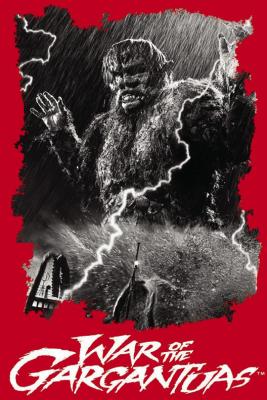One of the most influential kaiju films of all time: War of the Gargantuas
Comically Serious
After three domestic entries this October, let’s take a look across the Pacific at the monster farm that is Toho.
Toho is most famously known for being the parent company of Godzilla and has had a hand in producing every entry in the series. But aside from the Big G himself, Toho has produced many other monster films throughout the kaiju golden age of the 1960s, such as the subject here with War of the Gargantuas.
War of the Gargantuas was released in 1966 and served as a “quasi-sequel” to a movie we covered a few years back: Frankenstein Conquers the World. To recap, in Frankenstein Conquers the World, scientist found a feral boy running around in Hiroshima. The boy was revealed to have grown from the immortal heart of the Frankenstein monster after it was exposed to radiation when the bomb was dropped in 1945. They call him Frankenstein (yes, for those who are pedantic, Frankenstein was the doctor, not the monster) and eventually he grows to an enormous size and fights a giant monster called Baragon, before falling into the collapsing ground of a random earthquake and supposedly perishing (clearly they didn’t know how to end the movie).
This movie begins with a fishing boat being attacked by a giant octopus, all seems lost for the crew when a giant green-haired bigfoot-like monster attacks the octopus. Unfortunately for the crew, this is Gaira, and he is humanitarian… and by humanitarian, I mean he eats people.
Gaira begins attacking the coastal regions of Japan and is suspected to have been the Frankenstein monster previously raised by scientists, but then a second brown Gargantuas (called Sanda) emerges to save the other from the Japanese Self-Defense Force. Sanda was raised by humans initially and cares for them, this puts the two monsters (both grown from the cells of the original Frankenstein) against one another in a climactic brawl.
This movie was one of three that were co-produced between Toho and Henry G. Saperstein’s UPA, the other two being Frankenstein Conquers the World and Invasion of Astro-Monster (aka Godzilla vs. Monster Zero). Like those previous films, this movie had an American lead, although instead of Nick Adams, this movie starred Russ Tamblyn. Director Ishiro Honda, Saperstein and chief assistant Seiji Tani noted that Tamblyn was extremely difficult to work with and would often ignore Honda’s directions and improves lines without approval.
I mentioned that this film was a “quasisequel” and that remains the truth. While we get a general sense that the events that occurred prior to this movie were similar to Frankenstein Conquers the World, it is also clear that many things were different. Sanda for example seems to be the Frankenstein monster that was raised in captivity, and there is no mention of Baragon. Additionally, the characters are different, and not just in the case of recasting Tamblyn over Adams in the lead role. Kumi Mizuno plays an assistant to the head scientist in both films but in this one she is Dr. Akemi Togawa, whereas in the previous movie she was Dr. Sueko Togami. Much like Universal, Toho was no stranger to recycling actors, but the changes feel all the more apparent since these films feel like they could be in the same continuity.
Gaira is portrayed by Godzilla himself: Haruo Nakajima, and unlike his other monsters roles gets to emote way more. Since both monsters where humanoid, they were merely actors in the furry costumes with masks that allowed us to see there eyes. This allows both actors to be expressive and let us into the heads of both Gaira and Sanda, even though neither can speak. Additionally, since bulk suits weren’t used, this allowed the fight choreography to be far fast and more brutal than any other kaiju film of the era.
This movie is notable also for introducing something that would become a staple of classic Toho sci-fi: the Maser Cannon. While similar weapons appeared in earlier movies, the Type-66 Maser Cannon introduced in this movie resembles a satellite dish mounted on a truck that fires a jagged blue beam of energy resembling lightning. This weapons would make its way into the Godzilla franchise starting with 1972’s Godzilla vs. Gigan (and began the trend of using stock footage from this movie).
The term “gargantua” was made up for the US version of the film as opposed to using the monsters names or calling them “Frankensteins”, likewise, all reference to the Frankenstein Conquers the World were omitted as well. Tamblyn’s original dialogue soundtrack was lost during production and he was called back to re-dub his lines. Tamblyn worked without a script and had to rely on improvising his lines based on the footage’s lip movements.
Despite some problems (all of which seem to involve Russ Tamblyn) and one not so good singer in the middle of the movie, this one is regarded as one of the best of the genre and a true influential classic. That is no exaggeration as this movie has been cited as having an impact on creatives such as Brad Pitt, Quentin Tarantino, Tim Burton, Shusuke Kaneko, Guillermo del Toro, Attack on Titan author Hajime Isayama, and even the band Devo. Brad Pitt even cited it as the movie that inspired him to pursue acting at the 84th Academy Awards.
I highly recommend checking this one out, it is available on most streaming series.
Next time, we conclude our Halloween festivities with a movie that turned 100years old in 2022.


